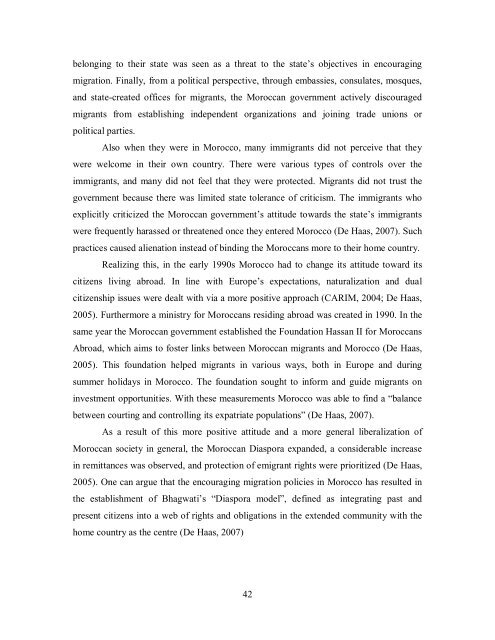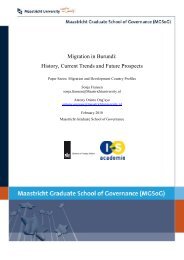Migration in Morocco: History, Current Trends and Future ... - MGSoG
Migration in Morocco: History, Current Trends and Future ... - MGSoG
Migration in Morocco: History, Current Trends and Future ... - MGSoG
You also want an ePaper? Increase the reach of your titles
YUMPU automatically turns print PDFs into web optimized ePapers that Google loves.
elong<strong>in</strong>g to their state was seen as a threat to the state’s objectives <strong>in</strong> encourag<strong>in</strong>g<br />
migration. F<strong>in</strong>ally, from a political perspective, through embassies, consulates, mosques,<br />
<strong>and</strong> state-created offices for migrants, the Moroccan government actively discouraged<br />
migrants from establish<strong>in</strong>g <strong>in</strong>dependent organizations <strong>and</strong> jo<strong>in</strong><strong>in</strong>g trade unions or<br />
political parties.<br />
Also when they were <strong>in</strong> <strong>Morocco</strong>, many immigrants did not perceive that they<br />
were welcome <strong>in</strong> their own country. There were various types of controls over the<br />
immigrants, <strong>and</strong> many did not feel that they were protected. Migrants did not trust the<br />
government because there was limited state tolerance of criticism. The immigrants who<br />
explicitly criticized the Moroccan government’s attitude towards the state’s immigrants<br />
were frequently harassed or threatened once they entered <strong>Morocco</strong> (De Haas, 2007). Such<br />
practices caused alienation <strong>in</strong>stead of b<strong>in</strong>d<strong>in</strong>g the Moroccans more to their home country.<br />
Realiz<strong>in</strong>g this, <strong>in</strong> the early 1990s <strong>Morocco</strong> had to change its attitude toward its<br />
citizens liv<strong>in</strong>g abroad. In l<strong>in</strong>e with Europe’s expectations, naturalization <strong>and</strong> dual<br />
citizenship issues were dealt with via a more positive approach (CARIM, 2004; De Haas,<br />
2005). Furthermore a m<strong>in</strong>istry for Moroccans resid<strong>in</strong>g abroad was created <strong>in</strong> 1990. In the<br />
same year the Moroccan government established the Foundation Hassan II for Moroccans<br />
Abroad, which aims to foster l<strong>in</strong>ks between Moroccan migrants <strong>and</strong> <strong>Morocco</strong> (De Haas,<br />
2005). This foundation helped migrants <strong>in</strong> various ways, both <strong>in</strong> Europe <strong>and</strong> dur<strong>in</strong>g<br />
summer holidays <strong>in</strong> <strong>Morocco</strong>. The foundation sought to <strong>in</strong>form <strong>and</strong> guide migrants on<br />
<strong>in</strong>vestment opportunities. With these measurements <strong>Morocco</strong> was able to f<strong>in</strong>d a “balance<br />
between court<strong>in</strong>g <strong>and</strong> controll<strong>in</strong>g its expatriate populations” (De Haas, 2007).<br />
As a result of this more positive attitude <strong>and</strong> a more general liberalization of<br />
Moroccan society <strong>in</strong> general, the Moroccan Diaspora exp<strong>and</strong>ed, a considerable <strong>in</strong>crease<br />
<strong>in</strong> remittances was observed, <strong>and</strong> protection of emigrant rights were prioritized (De Haas,<br />
2005). One can argue that the encourag<strong>in</strong>g migration policies <strong>in</strong> <strong>Morocco</strong> has resulted <strong>in</strong><br />
the establishment of Bhagwati’s “Diaspora model”, def<strong>in</strong>ed as <strong>in</strong>tegrat<strong>in</strong>g past <strong>and</strong><br />
present citizens <strong>in</strong>to a web of rights <strong>and</strong> obligations <strong>in</strong> the extended community with the<br />
home country as the centre (De Haas, 2007)<br />
42



